Soil/Landform Unit - Pyrenees Ranges
Landform Unit Description
Page top
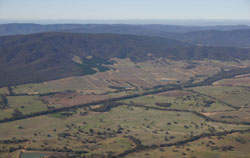 Pyrenees Ranges south of Landsborough |
1.01% of CMA region Mountains and hills of the Pyrenees Ranges constitute one large occurrence in the upper Wimmera River catchment, forming part of the east catchment boundary. This steep to rolling terrain unit belongs to the ridges, escarpments, mountains on non-granitic Palaeozoic rocks subdivision (2.1.1) within the Dissected Western Uplands. This terrain of broad high ridges lies to the north of Elmhurst. Steep mid slopes, broad ridges/plateaux, steeper upper slopes, gentler lower slopes and drainage lines all form parts of this landscape. Drainage lines radiate off this upland and feed a number of major rivers such as the Wimmera, Richardson and Avoca rivers. Soils are mainly red texture contrast soils (Chromosols) with yellow, brown and red sodic texture contrast soils (Sodosols) in the lower landscape positions. Sheet and rill erosion, and gully erosion are likely on cleared steeper slopes and lower landscape positions. Land cover influences water production along with groundwater recharge and discharge. Land use is predominantly native vegetation for conservation, water production, grazing, some timber production (and plantations) and viticulture on cleared lower slopes. Forests include Heathy Dry Forest and Grassy Dry Forest (exposed areas), Herb-rich Foothill Forest and Valley Grassy Forest (sheltered areas). | 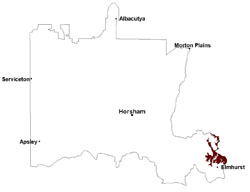 |
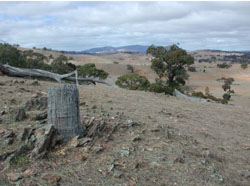 Cleared south-westerly hillslopes near Joel South | 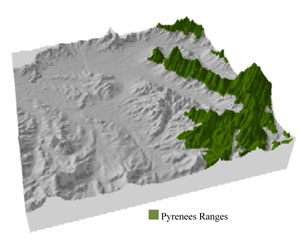 |
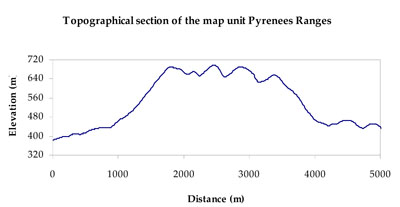 | 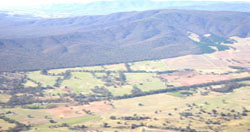 Dissected steep slopes with native vegetation |
Component | 1 | 2 | 3 | 4 | 5 |
Proportion of soil-landform unit | 10% | 7% | 63% | 15% | 5% |
| CLIMATE Rainfall (mm) | Annual: 670 | ||||
| Temperature (oC) | Minimum 7, Maximum 19 | ||||
| Precipitation less than potential evapotranspiration | October–March | ||||
| GEOLOGY Age and lithology | Quaternary fluvial gravel, sand and silt; Quaternary silt, sand & minor gravel (Shepparton Formation); Cambrian marine sandstone, siltstone and biotite schist (St Arnaud Group) | ||||
| Geomorphology | |||||
| LANDUSE | Uncleared areas: hardwood forestry for sawlogs, posts and poles; water supply; nature conservation; recreational activities Cleared areas: sheep and beef cattle grazing; water supply; viticulture | ||||
| TOPOGRAPHY Landscape | Mountains | ||||
| Elevation range (m) | 240–772 | ||||
| Local relief (m) | >300 | ||||
| Drainage pattern | Rectangular–dendritic | ||||
| Drainage density (km/km2) | 0.7 | ||||
| Landform | Hillslopes | Drainage lines | |||
| Landform element | Ridge | Very steep upper slope | Steep mid slope | Moderate to gentle lower slope | Drainage line |
| Slope and range (%) | 4 (0-20) | (>45) | 23 (15-45) | 10 (3-20) | 5 (1-35) |
| Slope shape | Convex | Convex | Straight | Concave | Concave |
| NATIVE VEGETATION Ecological Vegetation Class | Grassy Dry Forest (44.8%), Heathy Dry Forest (16.6%), Herb-rich Foothill Forest (14.6%), Valley Grassy Forest (6.2%), Other (15.4%) | ||||
| SOIL Parent material | In situ marine sandstone and siltstone | In situ marine sandstone and siltstone | In situ marine sandstone and siltstone | In situ marine sandstone and siltstone | Fluvial gravel, sand and silt |
| Description (Corangamite Soil Group) | Red texture contrast soils (1) | Red texture contrast soils (1) | Red texture contrast soils (1) | ||
| Soil type sites | LP83, DOAGW31, GW31 | ALRA81, DOAGW22, GW2 | |||
| Surface texture | Fine sandy loam | Fine sandy loam | Fine sandy loam | Silty loam (sandy) | Sandy loam |
| Permeability | High | High | Moderate to high | Moderate to slow | Slow |
| Depth (m) | < 0.5 | < 0.5 | 0.7 | 1.4 | > 2 |
| LAND CHARACTERISTICS, POTENTIAL AND LIMITATIONS Critical land features, processes, forms | Friable with better infiltration in moister areas, hardsetting and more prone to sheet and rill erosion in drier areas (north and westerly aspects). Susceptible to acidification in wetter areas. | Friable with better infiltration in moister areas, hardsetting and more prone to sheet and rill erosion in drier areas (north and westerly aspects). Susceptible to acidification in wetter areas. | Friable with better infiltration in moister areas, hardsetting and more prone to sheet and rill erosion in drier areas (north and westerly aspects). Susceptible to acidification in wetter areas. | Light loose surface soils that may be susceptible to wind, sheet and rill erosion in drier areas (including drier aspects). Poor subsurface drainage, particularly on lower slopes. Vulnerable to gully erosion where exposed. Susceptible to acidification in wetter areas. | Soils may be friable with better infiltration in moister areas, hardsetting and more prone to sheet and rill erosion in drier areas (including drier aspects). Sodic subsoil prone to gully and tunnel erosion. Poor subsurface drainage, particularly on flats and depressions. |


